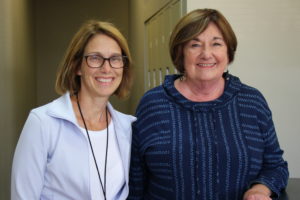Melanie Sargent: She Reversed Osteoporosis

Our client, Melanie Sargent, a 72-year-old retired insurance agent, was diagnosed with osteoporosis and started taking the drug Fosamax at age 50. Her doctor also recommended she start strength training, so in 1999, she started training with Bo Railey at The Training Zone (this was before Exercise Inc).
Osteoporosis literally means porous bone. It’s a disease in which the density and quality of bones is gradually reduced, greatly increasing the risk of fractures.
Bone is living tissue that is constantly being broken down by “bone crushing cells” (osteoclasts) and replaced by “bone building cells” (osteoblasts). Most of the adult skeleton is completely replaced every 10 years.
Osteoporosis occurs when the creation of new bone doesn’t keep up with the loss of old bone. It can affect men and women of all ages and races, but it is most common in women over 50.
One out of two women and one out of eight men will experience an osteoporosis-related fracture in their lifetime. The most common cause of osteoporosis is low estrogen, which is why it is so prevalent in women after menopause. Estrogen actually inhibits “bone crushing cells,” keeping bone from being broken down too quickly. Other causes include insufficient calcium intake or absorption, low vitamin D levels, smoking, and lack of meaningful physical activity, especially activity that puts stress on the bones.
A bone density scan is the only test that can diagnose osteoporosis. Bone density test results are reported using T-scores (a statistical term referring to standard deviations from the norm). A T-score shows how much your bone density is higher or lower than the bone density of a 30-year-old healthy adult.
A T-Score of -1.0 or higher indicates Normal Bone Density.
A T-Score between -1.0 and -2.5 indicates Osteopenia (Low Bone Density).
- Bones are weaker than normal, but not so far gone that they break easily.
A T-Score less than -2.5 indicates Osteoporosis.
- Porous bones that can fracture easily.
A study published in the Journal of the American Medical Association in 2001 reported that a 50-year-old white woman with a T-score of -1 has a 16% chance of fracturing a hip, a 27% chance with a -2 score, and a 33% chance with a -2.5 score.
Treatments for osteoporosis include prescription medications (Fosamax is the most popular), calcium and vitamin D supplements, and weight-bearing exercise. With the right approach, osteoporosis can be reversed, which is indicated by a higher T-score.
Our approach to exercise was actually the result of an osteoporosis research study conducted at the University of Florida in the early 1980s. In order for the subjects (post-menopausal with low bone density) to safely perform strength training exercises, the researchers had them lift weights at a super slow speed of motion (10 seconds up and 5 seconds down). This allowed the women to strength train in a safe manner. It also allowed them to produce a 30% greater increase in strength than had ever been produced in any other strength training studies.
The results of this early osteoporosis study were never published. However, there have been numerous studies published on the role of strength training in treating and preventing osteoporosis. A 2017 meta-analysis (a study that examines all published studies on the topic) found that high intensity resistance strength training provides the maximum benefit in increasing bone mineral density. But just how great can that benefit be?
Our client, Melanie Sargent, has found the benefit to be life changing. After 10 years of strength training and taking Fosamax, Melanie had a bone density scan that confirmed she no longer has osteoporosis, and she was able to stop taking Fosamax!
For the last 12 years, her diagnoses has been downgraded to osteopenia. She continues to strength train once a week, and she travels the world and enjoys life.
Check out Melanie’s Exercise Inc story!
Ready to Change Your Life In 20 Minutes A Week?
Give us a call today at 317-750-2219.

